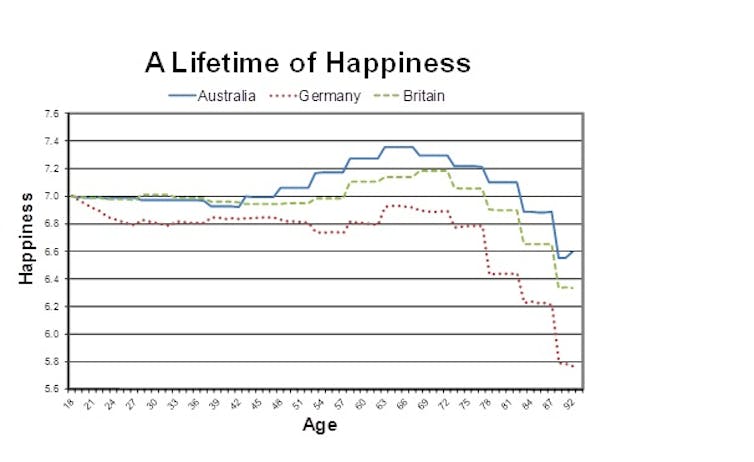People are at their happiest at retirement age and their most miserable in their geriatric years, according to a study we published recently in the Journal of Economic Behaviour and Organisation. Our findings effectively debunk the myth of middle-aged blues and show how happiness levels vary widely over a person’s lifespan.
We all strive towards happiness to achieve a sense of fulfilment in our lives. But there is also an economic reason to advocate this goal. Happier people tend to be healthier than those who are unhappy; and mentally unhealthy people are costly.
According to the Department of Health and Ageing and beyondblue, depression treatment costs the Australian community more than $600 million each year. It’s expected depression will be second only to heart disease as the leading medical cause of death and disability within the next 20 years.
Existing ideas of happiness
The notion that happiness is U-shaped over a person’s lifetime has gained a lot of momentum over the past decade. The U-shape of the happiness myth goes something like this: we were happy in our youth, became more miserable in our mid-40s, only to have happiness return in our late-50s. We then confront an inevitable happiness decline as our health fails in our late-70s and beyond.
Previous research supporting the U-shape model of happiness incorrectly assumed that life factors (such as level of income, education, marital status and health) remained constant over a lifetime. And rather than following an individual over many years to see how happy they are at different ages, researchers studied various groups of people at different stages of their lives whilst inappropriate presuming they shared the same characteristics.
New research
Our research interrogated the U-shape of happiness theory by examining how happiness levels changed in a sample of 60,000 people in Australia, Britain, and Germany, over many years.

We accounted for statistical limitations such as character traits and availability. This is important because being part of a study isn’t a random event: those who are busier (and perhaps happier in their middle-aged years) are less likely to take part in these studies. But happier (and therefore healthier) older people who have more time on their hands are more likely to be involved.
Hence the previous economic studies over-estimated the misery in mid-life and under-estimated it for very old people who were too sick to respond.
Unexpectedly, there was also the matter of increased honesty: Germans who were surveyed ten years in a row were significantly less happy than Germans interviewed at the beginning and end of the same period. The more a German talked, the unhappier she seemed to become; the dominant interpretation is that she became more honest about her true feelings and kept up a facade earlier on.
A similar thing occurs in Britain, but to a lesser degree. Australians had no such tendency. Correcting for both selectivity and dishonest reporting, we arrived at the wave-like profile below (click on the magnifying glass to zoom).

Our findings appear more in the line with the large body of psychological literature on the issue: there are no middle-age blues. Happiness is level through from about the age of 20 to retirement age (55 to 60), peaking at age 65 to 70 for Australians, then dropping increasingly fast as death approaches (80 to 90).
The same was found in Britain and Germany, though the happiness wave among the retired was far more pronounced there than elsewhere.
What’s next for happiness research?
One of the frontiers is how to promote happy personalities, which turn out to be extroverted personalities. Extroverts cope better with life shocks and are thus less stressed.
But how do we increase extroversion?
The short answer is we don’t know. Though the Penn Resiliency Program (PRP) of Professor Martin Seligman and his team at the University of Pennsylvania have been experimenting with telling school children how great they are, stimulating them to be open and extroverted. There are no results yet from these studies, but the idea is to look at whether we can educate children to be extroverted, and therefore happier, by stimulating their creativity and willingness to speak out.
Happiness policy is a relatively new concept in our society and we are only just getting used to the idea that it is something valid for our governments to worry about. We want our children to grow up as happy adults so we need to promote happy personality traits.
Meanwhile it is comforting to know that the happiest years come after retirement! Something to look forward to rather than dread.

